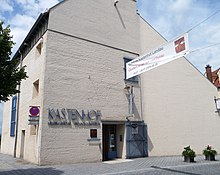Lower Bavarian Archaeological Museum
The Lower Bavarian Archaeological Museum is a museum opened in Landau an der Isar in July 1995 as the eleventh branch of the State Archaeological Collection . In 1997 the collection was awarded the "European Museum Prize" from among 66 applicants. The museum found a home in the so-called Kastenhof , the former residence of Duke Ludwig des Kelheimer , who is considered the founder of Landau ad Isar (1224). After a redesign phase, the museum will reopen on October 27, 2019 under the name Kastenhof Landau - The Museum for Stone Age and Present .
Exhibition and exhibits
At the beginning of the exhibition course there is a multimedia and individually usable introduction to the work of archaeologists, aerial archeology and the basics of archeology . The museum is then divided into four main sections with the main topics “From the hunter to the farmer”, “Magic and religion”, “City” and “History of the Bavarians”. In addition to numerous excavation exhibits, the walk-in replica of a Stone Age house is on display. The objects on display range from the Middle Stone Age to the formation of the state and Christianization of the Bavarians . The exhibition houses two curved gold sheets (hair ornaments) that were found in 1998 in Aufhausen in the grave of a little boy from the bell-cup culture . The tomb is dated around 2200 BC. To date, so it is the oldest gold objects in Bavaria.
Special exhibitions
A glass-roofed, winter garden-like extension was added to the Kastenhof as part of the museum's construction. This area, separated from the rest of the museum, is used for special exhibitions. From May 5 to October 29, 2006, the special exhibition “ Ötzi , the Ice Man” with a faithful replica of the glacier mummy was on view here.
Web link
Individual evidence
- ↑ Reopening of the museum. Website of the Lower Bavarian Archaeological Museum, accessed on October 18, 2019.
- ↑ Tobias Bosch: Archaeological investigations on the question of social structures in the eastern group of the bell-cup phenomenon based on the finds. Dissertation, University of Regensburg, 2009 ( PDF; 28.3 MB)
Coordinates: 48 ° 40 ′ 7.3 " N , 12 ° 41 ′ 23.6" E

